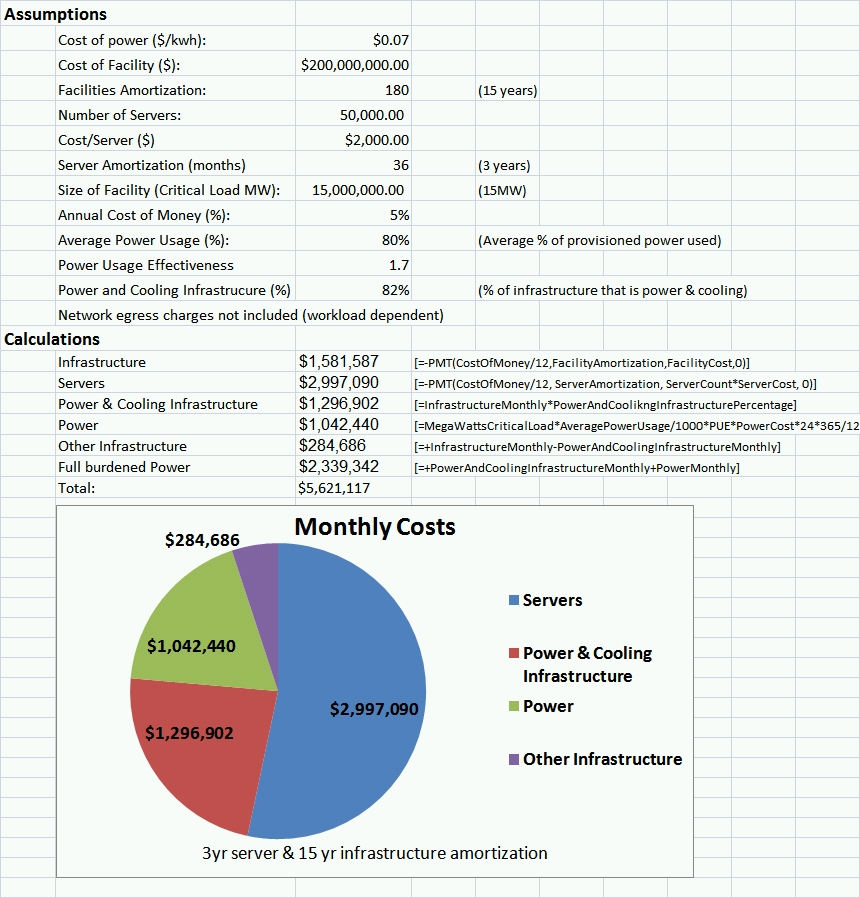Отличная пошаговая инструкция стратегу!

Как уменьшить долю электричества в стоимости ЦОД
В блоге у James Hamilton опубликован пример расчета стоимости инфраструктуры для очень большого ЦОД (Perspectives – Cost of Power in Large-Scale Data Centers). Видно, что если учесть стоимость всей потребляемой мощности и стоимость электрической и охлаждающей инфраструктуры для ее подвода и использования, то стоимость “питания” почти равна стоимости серверного оборудования. Для сопоставимости расчетов все затраты помесячно нормированы, т.е. переведены в категорию OpEx с соответствующими сроками амортизации. Возможно приведенная модель не учитывает все затраты, характерные для ЦОД любого масштаба (люди, сети, стоимость ПО и т.д.), но здесь важно другоею
Мне часто приходится слышать, что для России подобные расчеты не актуальны, т.к. у нас дешевое электричество. Из данной модели видно, что это не так. Стоимость электричества в ней берется $0,07 за квтч., что по сегодняшнему курсу ЦБ составит 1 р. 96 к. Для справки в Московском регионе по одноставочному тарифу (http://rek.mos.ru/section/45) цена для промышленности колеблется от 1,16 до 2,06 рублей, т.е. абсолютно сопоставима.
Кроме того, что электричество начинает стоить как серверы, его еще проблематично получить в объеме, необходимом для питания традиционной физической инфраструктуры. По опыту внедрения VMware Virtual Infrastructure мы наблюдаем среднее снижение объемов энергопотребления в 8-10 раз. Подробности можно узнать здесь и здесь.
Как говорится выводы делайте сами J

What can we learn from this model? First, we see that power costs not only don’t dominate, but are behind the cost of servers and the aggregated infrastructure costs. Server hardware costs are actually the largest. However, if we look more deeply, we see that the infrastructure is almost completely functionally dependent on power. From Belady and Manos’ article Intense Computing or In Tents Computing, we know that 82% of the overall infrastructure cost is power distribution and cooling. The power distribution costs are functionally related to power, in that you can’t consume power if you can’t get it to the servers. Similarly, the cooling costs are clearly 100% related to the power dissipated in the data center, so cooling costs are also functionally related to power as well.
We define the fully burdened cost of power to be sum of the cost of the power consumed and the cost of both the cooling and power distribution infrastructure. This number is still somewhat less than the cost of servers in this model but, with cheaper servers or more expensive power assumptions, it actually would dominate. And it’s easy to pay more for power although, very large datacenters are often located to pay less (e.g. Microsoft Columbia or Google Dalles facilities).
Since power and infrastructure costs continue to rise while the cost of servers measured in work done per $ continues to fall, it actually is correct to say that the fully burdened cost of power does, or soon will, dominate all other data center costs.
For those of you interested in playing with different assumptions, the spreadsheet is here: OverallDataCenterCostAmortization.xlsx (14.4 KB).
Новость про автора этого расчета у Мэри Джо: http://blogs.zdnet.com/microsoft/?p=1765 James Hamilton, an architect on Microsoft’s Data Center Futures team, has decided to leave Microsoft for Amazon.com, as TechFlash first reported.Hamilton is known at Microsoft for his work to popularize the container-model for datacenters. He was a member of Chief Software Architect Ray Ozzie’s Live Platform Services development team. Hamilton’s interests included “multi-tenant hosted systems, the management of very large scale systems, massively parallel data management systems, database security, and unstructured data management.” Before joining the Live Core team, Hamilton was the general manager of the Microsoft Exchange Hosted Services team, and before that, SQL Server Architect and leader of the Security and Incubation Team.